Wołłowicz Palace in Svyatsk

A beautiful residence of the Wołłowicz (also spelled as Volovich) family that left a mark on the history of several countries, an estate steeped in legends, an upscale rehabilitation center, a hospital and a sanatorium... Many events and roles were intertwined in the history of Wołłowicz Palace, which was compared with the royal residence in Versailles. Today it is being rededicated as a museum celebrating the Wołłowicz noble family and the entire Grodno land. It is an atmospheric tourist attraction inviting visitors to take a journey through several centuries.
The origins of Wołłowicz Palace
The village of Svyatsk, located 20km from Grodno, was first mentioned in chronicles inthe 16th century. King Sigismund I the Old granted the land to Prince Sopotko, who founded the estate. The place passed through a number of hands over the centuries: some gave it as a dowry; others sold it in whole or in parts. In the second half of the 18th century the fragmented Svyatsk lands were united by Józef Wołłowicz. His son Antoni bought several other neighboring estates. That was how Veliky Svyatsk came into being.
The Wołłowiczes were one of the most influential families in the Grand Duchy of Litva (Lithuania), along with the Radziwills, Sapiehas, and Chodkiewiczes. Family legends say that the name originated from a semi-legendary warrior named Vol - one of the bodyguards of Polish King and Lithuanian Grand Duke Casimir: a mighty brave man saved the monarch's life... One of the notable representatives of the family was Ostafi Wołłowicz - a statesman, humanist and educator, one of the authors of the Statute of the Grand Duchy of Litva (Lithuania).
The construction of the family residence in Svyatsk began in 1779: the work was initiated by Grodno Marshal Józef Wołłowicz, and after his early death the work was continued by his son Antoni Wołłowicz, a senator of the Polish-Lithuanian Commonwealth, who received the title of Prussian count, which was later confirmed in the Russian Empire.
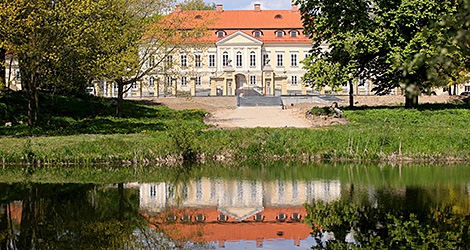
The magnificent palace, which became the largest residence of the family, was designed by Giuseppe de Sacco, the famous master of his time, court architect of King Stanisław August Poniatowski. He participated in the rebuilding of the cathedral in Vilna and the church of St. John the Baptist in Warsaw, reconstructed the New Castle in Grodno and designed many other buildings of the royal city, famous palaces and parks of the princely families in Belarus.
Designed by Giuseppe de Sacco, the palace in Svyatsk combined the most characteristic features of three styles: Baroque, Classicism and Romanticism (interior decoration).
The two-story central building and symmetrically located wings were connected by semicircular galleries decorated with colonnades. The main building had a gambrel roof with an attic. The wings housed living quarters and a riding school. However, the wings were built later than the palace itself - at the beginning of the 19th century - and probably to the design of another architect. The galleries connecting the central building with the side extensions were not glazed at first. They got windows after remodeling in the first half of the 20thcentury. There is a semicircular fence with an entrance gate at the front courtyard. It was added in the new millennium based on one of design drawings.
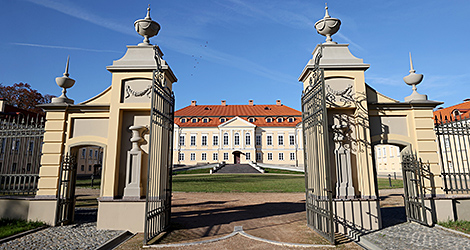
The first floor of the central building was designed as a corridor, the second as an enfilade. The main building housed ballrooms and living rooms. A grand three-flight staircase led to the second floor. The rooms were richly decorated with stucco, columns, pilasters, and portals. The walls were painted in the grisaille technique, presumably by artists Mankowski and Smuglewicz. Parts of the stucco, fireplaces and door frames have survived to this day.
In the late 18th - early 19th century, a landscape park based on a regular layout was planted around the palace. It had a cascade of four ponds. Hornbeams, maples, pines, exotic Douglas fir trees were planted in the park... Unfortunately, many species, including rare ones, perished during the two world wars.
Across the road from the estate, a small chapel-tomb in the neo-Gothic style was built in the late 19th century: it has survived and will soon be restored. Outbuildings have also survived and got a new lease on life. A restaurant-brewery opened in one of them.
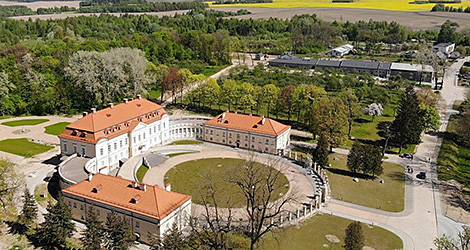
A legend has it that a young Wołłowicz lady fell in love with a stableman. The angry father ordered the young man to be drowned in a pond, and the disgraced girl to be walled up alive in one of the columns of the house. The restless shadow of the young woman is supposedly still roaming around. Yet there is no evidence that such a cruel thing really happened!
Throughout its history, the Svyatsk estate was inherited, received as a dowry, sold, even gambled away, and seized for debts. The gambling story has never been confirmed, however.
In the first half of the 20th century the palace became the property of the Ministry of Health of Poland. A decision was taken to restore the building damaged during the First World War. Following the makeover in the 1930s, the palace was turned into an elite medical center (sanatorium) to treat patients suffering from nervous exhaustion and various addictions.
After the Great Patriotic War, the palace in Svyatsk, already part of the USSR, was also used to house a medical institution. At first it was a hospital, and later a health resort. In independent Belarus, the former estate housed a rehabilitation center for tuberculosis patients. The center operated until the mid-2000s. Later the palace became the property of the Ozerny health resort and the building was mothballed until better times.
Wołłowicz Palace and Park Ensemble in Svyatsk today
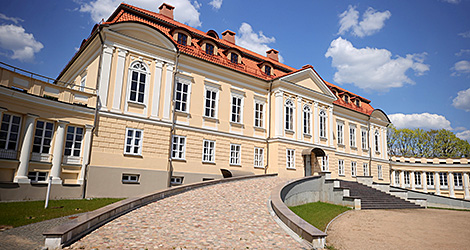
The restoration of the ancient estate kicked off in 2016. Since then, the pearl of Svyatsk has been gradually regaining its former glory. The first stage of reconstruction works completed in the spring of 2023. They included the full restoration of the exterior of the palace and the courtyard. The wings and galleries got renewed finishing.
Today a hotel operates in the wings of the palace. There is also a SPA-center, exhibition and conference halls.
The old building, which used to be a barn, houses a restaurant and brewery. The Svyatsk Brewery produces several varieties of craft beer with original names dedicated to the history of Svyatsk.
For the time being visitors can admire the main building from outside as the restoration of the interior is still underway. It is to be completed in 2025. Plans are in place to open a museum in the central building, restore the interiors of the palace to feature the ancient furniture and rare items.
Throughout the year, the palace hosts musical evenings, folk festivals, and wedding ceremonies.The list of traditional events to be hosted by the restored estate will surely include:
-
the ball in Wołłowicz Palace;
-
the culture festival Svyatsk Craftfest;
-
the Kupala Round Dance in Svyatsk festival;
-
Svyatsk Triathlon.
How to get there and where to stay
If you travel by car from Minsk, take the M6 highway to get to Grodno first and then go to the northwest from Grodno using the H6054 road.
You can also get to Svyatsk by public transportation from Grodno using the bus service Grodno - Sopotskin, Grodno - Nemnovo, Grodno - Goryachki, Grodno - Kalety. The buses run every day.
You can stay in the palace complex: nowadays its wings house comfortable rooms of the Svyatsk Palace park-hotel.
Address: Grodno District, Sopotskin village council, Svyatsk village.
Coordinates: 53.797433,23.660924
Places of interest not far from Wołłowicz Palace
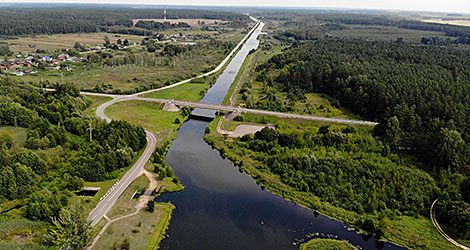
There is a unique hydraulic engineering facility near Svyatsk: the Augustow Canal. There are only three canals like this in the world. The waterway with a total length of nearly 101km starts at Lake Serwy near Polish Augustow and stretches virtually to Grodno. The canal connects the Vistula River and the Neman River through the Bebzha River, the Netta River and the ChernayaGancha River.
The agro-town of Sopotskin is another place worth visiting. It was founded over 500 years ago and is located a few kilometers from Svyatsk. The main attraction in Sopotskin is the Church of the Assumption of the Virgin Mary and Saint Iosif Kuntsevich, which was built in 1789 and combines architectural features of Baroque and Classicism. The church underwent reconstruction in the late 1980s, after which the towers, which had been demolished in the 19th century when the building became an Orthodox monastery, were restored.
The local cemetery also has several notable neo-Gothic chapels from the 19th century. They are the burial places of the owners of the Sopotskin estate: Julia Dziekonska and Jozef Gurski.
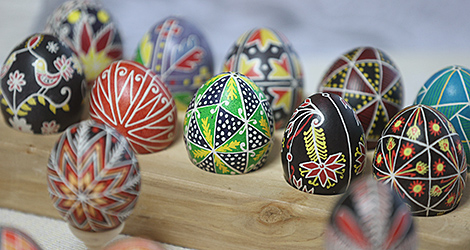
The unique Pisanka Museum is also a must-see. The special Easter eggs decoration technology born in Sopotskin is included in the list of the intangible cultural heritage of Belarus. The museum houses a rich collection of over 1,500 exhibits. Besides chicken eggs, you can see painted goose, ostrich and quail eggs. The museum not only showcases already painted eggs, but also offers egg painting workshops.
Almost 30km from Grodno in the village of Radzivilki there is the Svyatsk Gurski manor complex. It functions as a hotel. The complex is relatively new and more modest than Wołłowicz Palace. The one-story stone house was constructed in 1828. At the beginning of the 20th century, a two-story building was added to it. There are also five ponds near the estate.







 print version
print version make home page
make home page add to bookmarks
add to bookmarks







